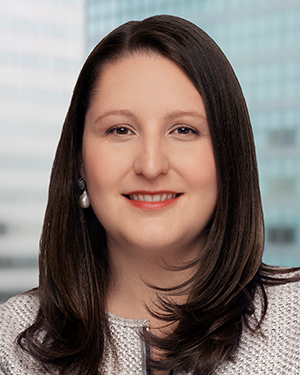Blackstone Mortgage Trust Inc. has grown its loan portfolio to a record high $18.7 billion, and its leaders see more runway for growth ahead. President Katie Keenan is poised to play a bigger role in guiding that strategic expansion.
As part of the firm’s multi-year transition plan, Keenan will assume the role of CEO on June 30th and also join the BXMT Board of Directors.
WMRE recently talked with Keenan to hear more about the near-term strategy for the REIT, as well as her insights on CRE market activity, the competitive lending environment and what impact inflation could have on borrower demand.
This interview has been edited for style, length and clarity.
WMRE: BXMT closed on $1.7 billion in new originations in first quarter. Can you put that into context compared to pre-pandemic levels?
 Katie Keenan: It’s a strong number. We continue to see the benefits of all the competitive advantages that we have in sourcing investments for our portfolio. The scale and reach that we have across the market, the information flow, all of our relationships—that has really put us in an advantageous position as we see transaction activity in the market increase.
Katie Keenan: It’s a strong number. We continue to see the benefits of all the competitive advantages that we have in sourcing investments for our portfolio. The scale and reach that we have across the market, the information flow, all of our relationships—that has really put us in an advantageous position as we see transaction activity in the market increase.
$1.7 billion is in line with where we have been in our most active years, and it was up 33 percent from last year. That led us to a record portfolio size of $18.7 billion at the end of first quarter. So, we have a lot of momentum, and we are well positioned for what we are seeing in the market.
WMRE: What’s your typical sweet spot for loans. Do you have a certain size range or type of loan product that is more prevalent?
Katie Keenan: The most important thing we focus on is the sponsorship of the asset and the credit of the loan. We have a wide range of loans, but all are low leverage, first mortgage loans, institutional quality assets, and critically, focused on well-capitalized, experienced borrowers. That strategy has generated differentiated performance for our portfolio historically and over the last year.
We will originate loans of $50 million and up. Our largest loan to date is $1.8 billion, and we like large transactions, because they tend to be accompanied by high quality assets, strong sponsors and lots of cash equity in the deal.
WMRE: Do you have a favored property type or types that you would like to add to the BXMT portfolio?
Katie Keenan: We are seeing great activity in the multifamily space. That’s an area that is a big focus for us at BXMT and the entire Blackstone business because of the resiliency of the asset class and the growth that we are seeing. We’re also seeing strong activity in life sciences, industrial, growth market office deals and a resurgence of activity in Europe as well, which we think is good relative value from a lending perspective. We are selective on hotels given that we are still in an interim period, but we think there are some unique, compelling relative value opportunities in that sector as well as we see the post-COVID travel recovery taking hold.
WMRE: Can you share any numbers on portfolio concentration?
Katie Keenan: Our portfolio as a whole is made up of approximately 50 percent office, and it’s generally low leverage with strong sponsorship that has performed really well. We are seeing incremental growth in multifamily, life sciences and industrial, and that is a good fit for the overall portfolio.
WMRE: So, if you have 50 percent of your loan portfolio in office currently, are you trying to shift new loan origination away from office?
Katie Keenan: It’s more that we’re seeing a relative increase in transaction activity in multifamily, life sciences and industrial. We continue to like the segment of the office market we’ve focused on historically—newer quality assets with strong amenities in submarkets with dynamic sources of demand. For example, we have a lot of office in West L.A. where content creation continues to drive office activity. We’re very interested in those types of opportunities. Growth in transaction activity changes quarter to quarter, but especially in the first quarter, there was a lot of activity in those three sectors.
WMRE: You mentioned you were selective on hotels. How do you view retail?
Katie Keenan: I hesitate to paint the whole sector with a broad brush, but the enclosed malls and soft goods stores that are more displaced by e-commerce are still very challenging.
WMRE: What are you seeing for loan modification requests? When did that activity peak, and are there still some requests trickling in?
Katie Keenan: Our modifications over the COVID-impacted period were largely characterized by sponsors wanting to invest more capital and see their assets through the period of volatility. They believe in the long-term value of the assets, as we do. Because we had chosen the right sponsors, they had the capital to carry their assets through. Most activity in that range occurred last summer, and our portfolio maintained excellent credit performance throughout last year, as it has historically.
Today, we are focused on our more typical asset management strategy, which is proactively identifying opportunities with the loans that we have to extend, right-size terms and otherwise work with our borrowers to keep our high quality loans around for longer. That has been a part of the secret sauce of the business for a long time. We have very close, bilateral relationships with our borrowers, and that allows us to make sure that the loans work well for them wherever they are in the business plan for the asset. That enables us to keep well-performing loans in our portfolio for a longer period of time.
WMRE: How would you describe the overall appetite for capital and where are the “hot spots” or big drivers for demand?
Katie Keenan: Aside from the property sectors that we have already talked about, we are seeing a much more normalized acquisition environment. I think that is driven by real estate investors having substantial capital available and feeling that now is a good time to invest that capital in real estate assets. There’s a positive macro dynamic and good valuations, and that has led to a lot more acquisition activity.
WMRE: We are seeing pretty good momentum with this recovery and good liquidity in both equity and debt. How would you describe the competitive landscape in the lending sector?
Katie Keenan: Our market has always been competitive. The fact that we have consistently been able to outperform in terms of the types of loans in our portfolio is driven by our position as part of the overall Blackstone platform. We have a real advantage in terms of the depth of the relationships we have with borrowers, with advisors and all of the players in the market, and that enables us to see a wide range of potential lending opportunities, putting us in a position to capture the ones that we think are the best fit for our balance sheet.
The platform advantage also comes through in our ability to stay at the leading edge of financing markets and drive our cost of capital down. We function in an environment where there is competition, but because of our access to deals and our access to very well priced capital, that has allowed us to stay ahead of the curve and find the best opportunities for the company.
WMRE: Is competition putting pressure on spreads and rates?
Katie Keenan: We have generated very stable, consistent current income from our portfolio, which is first mortgages, throughout the history of the company, and that has supported a very stable dividend. That dividend yield is around 7.5 percent today, which we think is attractive relative to the other investment opportunities in the market.
The reason for that stability in different spread environments, and there is some pressure on spreads today, is that we are on both sides of the dynamic. As a lender to our borrowers, we see spread compression, but as a borrower from banks and the CLO market, we are able to benefit from that spread compression from the perspective of our financing costs. It creates a very nice parallel where, when there is tightening in the market, we can still keep our income very stable because we benefit from some of that competition on our borrowing costs.
WMRE: What, if any, challenges or headwinds do you see ahead for the CRE industry or mortgage sector specifically in the coming year?
Katie Keenan: Certain sectors are challenging, retail being one. We also are mindful of the impact of potential inflation. Our business in general is very well positioned relative to others out there in an inflationary environment. We’re lending on a low leverage basis, floating rate, on real estate assets that, ultimately, should see growth in the event there is inflation. But it is something that we spend time thinking about as we’re underwriting, whether it’s from a construction cost perspective or an operating cost perspective. But it is also something where we think our portfolio could be well positioned relative to other businesses.
WMRE: As the new CEO, you are one of the few women who have made it past that glass ceiling in the CRE industry. How is Blackstone addressing issues of diversity, equity and inclusion?
Katie Keenan: It’s a huge focus for the firm. We really believe that creating a greater representation of opinions, backgrounds and experiences can help us make better investment decisions. Our investment process involves bringing together a lot of perspectives, and we want to make sure those perspectives are diverse. I think we have made a lot of progress. Forty-five percent of our analyst class this year are women—compared to 20 percent six years ago—and 44 percent is racially diverse.
It’s about bringing people in the door but also supporting them and developing them while they’re here. There has been a lot of focus within the firm on that too, both in formal affinity groups and informal mentorship and sponsorship, and just generally fostering a supportive and meritocratic culture. While we are making progress, we know there is still a lot of work to do.

